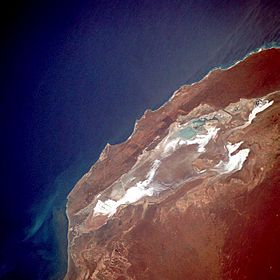Lake Macleod facts for kids
Quick facts for kids Lake Macleod |
|
|---|---|

Lake Macleod as viewed from space (in 1989).
|
|
| Location | Gascoyne, Western Australia |
| Coordinates | 24°07′04″S 113°39′27″E / 24.11778°S 113.65750°E |
| Type | Freshwater |
| Primary inflows | Lyndon River, Minilya River |
| Basin countries | Australia |
| Surface area | 1,500 km2 (580 sq mi) |
| Average depth | 1.5 m (4.9 ft) |
| Max. depth | 1.5 m (4.9 ft) |
Lake Macleod is a large lake in Western Australia. It is the westernmost lake in all of Australia. You can find it in the Gascoyne region, which is north of the small coastal city of Carnarvon.
Contents
History of Lake Macleod
Long ago, in 1616, a Dutch explorer named Dirk Hartog was the first European to officially land near this coast. Early explorers who visited this area noticed that the ocean tides here were incredibly high and low.
About Lake Macleod's Environment
The weather in this part of Western Australia is greatly affected by the Western Australian Current. This ocean current flows north and brings cool water from near Antarctica. Because of this cool current, it doesn't rain much inland.
This cool ocean current, along with the very flat land near the coast, creates a dry, desert-like environment. You can see this in the brownish landscape around the lake. The bright white areas within the lake are highly reflective salt beds.
The lowest part of the lake seems to be near its northern end. Here, lighter blue colors show where some water usually stands. If you look closely at satellite images, you can see faint lines at the very southern end of Lake Macleod. These are large areas called evaporation beds. Here, water is left to evaporate, which helps produce high-quality salt and gypsum.
Lake Macleod as a Wetland
Lake Macleod is recognized as an important wetland by the DIWA. It is a great example of a large coastal lake that sometimes gets flooded with fresh water.
Birds of Lake Macleod
About 382 square kilometers of the permanent ponds in the northwestern part of the lake are very important for birds. BirdLife International has named this area an Important Bird Area (IBA).
Many different bird species live here. These include fairy terns and a large number of red-necked stints, curlew sandpipers, banded stilts, red-necked avocets, and red-capped plovers. You can also find a population of dusky gerygones.
The northern ponds are made of mudflats that are sometimes flooded. The water here can be a bit salty or very salty. There are also salty springs and permanent salty channels and lagoons. Many red knots, Australian pelicans, little black cormorants, black-tailed godwits, and black-winged stilts have been seen here. A good number of canary white-eyes also live in this area.
Studies show that the lake is very important for shorebirds. It hosts significant numbers of 10 different species. Three of these – the red knot, red-necked stint, and curlew sandpiper – are found here in internationally important numbers.
See also
 In Spanish: Lago Macleod para niños
In Spanish: Lago Macleod para niños


